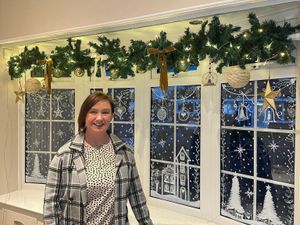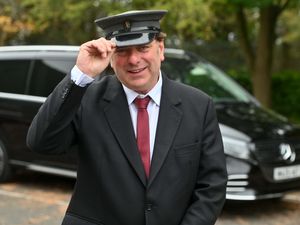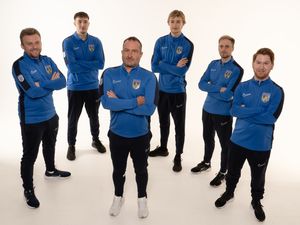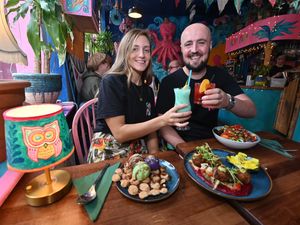Guide Dogs play a key role in supporting those facing the challenge of sight loss
Most of us take being able to walk down a busy street, catch a bus or nip to the shops for granted.
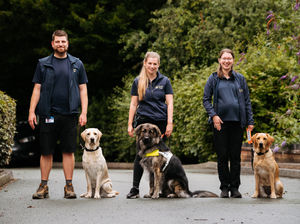
But for someone living with sight loss these can sometimes be challenging and overwhelming experiences.
This is where guide dogs can be a real lifeline, providing a safe and effective way for people to maintain their independence.
Before this special bond can be formed, a canine companion must undergo extensive training.
The Guide Dogs team in Shrewsbury works to ensure that dogs have the skills required to help their owners get out and about with confidence.
Mobility specialists (GDMS) are responsible for training dogs, matching them with a suitable client and supporting that unique partnership.
There are currently around 3,551 active partnerships - where a person with sight loss has been matched and qualified with a guide dog - nationally, including 191 in the Black Country, Staffordshire and Shropshire.
In 2021, the charity, which was founded almost 90 years ago, set up its Academy to train the next generation of guide dog trainers and guide dog mobility specialists.
Shrewsbury is one of 11 sites across the UK where new recruits are receiving coaching from technical learning specialists (TLS).
There are currently three TLSs, who are responsible for training nine learners at the centre. They include Lauren Pringle, aged 29, who has been working for Guide Dogs since 2017 and became a TLS around 18 months ago.
“Before Guide Dogs, I attended college and completed a degree in animal behaviour and then went on to do a masters in anthrozoology, which is the study of interactions between the animal-human bond,” she explains.
“Alongside this I worked with a clinical dog behaviourist and worked as a graduate assistant at my university, these elements built up my practical knowledge with working with dogs and people.”
“It’s the best of both worlds. It’s a very enjoyable job,” adds Lauren.
Fellow technical learning specialist Emma Mellor joined the charity in 2015, after considering a career as a dog handler in the RAF.
While visiting Shrewsbury Flower Show, the Guide Dogs stand caught her eye and she spoke to a member of staff to find out more.
She became a volunteer working in a wide range of roles, including being a puppy raiser – someone who prepares young dogs for their future career – and as a sighted guide for the organisation’s My Sighted Guide service, which helps people with sight loss get out and about,
Alongside this, she also gained experience working with children with special educational needs before becoming a mobility specialist for of Guide Dogs and more recently a TLS.
“People always think it’s a dog job, but it’s a people job,” Emma says. “I enjoy the variety. You never get any dogs the same, you never get any clients the same and you never get any trainees the same.”
Will Radford-James is about half-way through the three-year training programme at the Academy and once completed will qualify as a mobility specialist.
He had previously been a stud dog holder for Guide Dogs, helping to bring the next generation of canine companions into the world, while working as a sports therapist.
The 30-year-old has also been a fosterer for the charity which gave him an insight into the work of the mobility specialists.
He is currently training 16-month-old yellow Labrador Hettie, who is proving to be a fast learner.
“It’s really fun working as a group of people rather than just by myself and learning from other people and working with different dogs,” says Will.
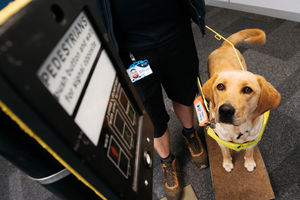
The charity welcomes around 1,000 puppies into the world every year with many born at the charity’s National Breeding Centre, located just outside Leamington Spa, or at home with volunteer breeding dog holders.
Labradors, golden retrievers and German shepherds have been, and remain, the most common pure breeds on the programme.
But historically the golden retriever crossed with the Labrador has produced the most successful guide dog of all, combining many of the great traits of both breeds.
Other breeds such as curly-coated retrievers, and standard poodles have also been crossed with established breeds to offer secondary benefits such as shedding less hair which may be advantageous to owners with allergies.
At the age of six weeks, they start their initial training with a puppy raiser, who plays a vital role in their early socialisation and education.
They are introduced to different sights, smells and sounds – such as busy roads and public transport – and they also attend classes to learn how to behave properly around other people and dogs.
They are taught to walk ahead on the lead and obey simple commands such as sit, down, stay and come.
When the puppy is between 12 and 14-months-old, they are ready to start their basic training and are looked after by a fosterer during evenings and weekends.
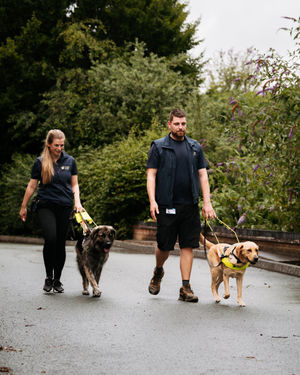
Guide Dogs has four training schools which are in Forfar, Redbridge, Leamington and Atherton.
Here they learn to walk in a straight line unless there’s an obstacle, not to turn corners unless told to do so, to stop at kerbs and wait for the command to cross or turn left or right.
They also learn to judge height and width so that their owner does not bump their head or shoulder and to get used to traffic.
Once they have finished this stage, they start their advanced training with the mobility specialists.
The dogs continue to live with fosterers but are dropped off at the Shrewsbury centre from 8.15am and collected by 5.45pm.
The team uses positive reinforcement training – the dogs arrive with a ‘packed lunch’ and they get the chance to earn some of their food during the day. By using this method, the dogs learn that working is rewarding, which means that they are engaged with trainers and look forward to their work.
Co-operative care is another important part of their training which is about giving dogs choice and control.
The goal is to teach dogs to actively participate in their own care, such as handling and veterinary procedures.
Having the ability to opt in and out of something increases a dog’s confidence and builds their trust in their owner.
“If the dog doesn’t want to do it, we stop. We teach our clients to check for an ear infection by lifting the ear and smelling.
“There is a distinctive smell to an ear infection,” explains Emma.

Another training method involves a small platform and the dog is trained to go to the platform ignoring whatever distractions there may be such as other dogs or food.
Once they are standing on the middle of the platform, having successfully taken no notice of what else is going on around them, they receive their reward.
This is one of the ways dogs are trained to guide their owners safely to kerbs and the top of steps.
They are also taught to walk centrally along the pavement whilst avoiding obstacles on the route and not to turn corners unless told to do so.
They have also learned to find doors, crossings and places which are visited regularly and to judge height and width so their owner does not bump their head or shoulder.
A dog can also help their owner keep straight when crossing a road – but it is up to the owner to decide where and when to cross safely.
They still need to be given commands, which is why, in order to form a successful partnership, Guide Dogs recommend applicants have established routes they want to walk with a dog.
“Sometimes people come to us not understanding what a dog will do for them. The dogs follow directions and have to be told where to go.
“They are trained to move forward in a straight line and to turn right or left. It’s really important that people have all their routes in place and can confidently direct the dog,” explains Emma.
Dogs also learn ‘intelligent disobedience,’ such as refusing to obey a forward command if there is a car approaching.
Not all dogs the team come into contact with will qualify to become a guide dog due to health reasons, skills or behaviour – but they still make great pets.
The first dog Will worked with, a black Labrador named Perdie, was unfortunately withdrawn from the programme.
“He was like a train going forward, he pulled on the lead constantly. He was incredibly strong. It was a learning experience – he was a very difficult dog to train,” he explains.
“It was Perdie’s decision not to work with his client and we listened to him,” he explains.
Perdie was successfully rehomed and his training did not go to waste. “It helped him to have a nice life as a pet dog. A lot of what Will did with him was dog training, rather than guide dog training,” say Emma.
“We’ve had a few dogs where we knew early on they were not going to be guide dogs but we’ve still spent the maximum time with them to help them be rehomed.
“As a team, we are passionate about doing what’s right for the dog and setting them up for success,” adds Lauren.
Once a dog has successfully completed 10 weeks of advanced training, they are matched with someone from the waiting list.
When creating a partnership, there are many factors to consider such as the speed the person and the dog naturally walks, how much a person does each day and how active the dog is.
Some dogs thrive in more urban environment with lots of noises while others will fare better in a rural spot.
Children and other pets also need to be taken into considering during the process.
“They are only guide dogs for 20 per cent of the time, the rest of the time they are a pet dog. It’s important to match the right dog to the right person,” says Emma.
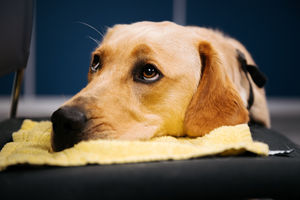
Once they are matched the owner and guide dog will then train together with a mobility specialist for five weeks.
For the first fortnight, sessions usually take place at a hotel and are followed by three weeks back at their home and surrounding area.
Owners will learn how to care for their new pet as well as general dog-handling skills.
They will also go on walks with their dog and gain experience in a variety of environments and everyday situations.
Lauren says this is always a rewarding time for the mobility specialists. “With one of my first partnerships, we did a long route next to a busy road.
“At the end, the client said ‘I felt like I had my old eyes back’. It was such an emotional moment and shows how much it can improve people’s lives,” she recalls.
If the training is successful, their new four-legged friend is awarded with a white harness and their working partnership begins. A guide dog will normally work for around eight years before they retire.
Guide dog owners receive regular visits from a mobility specialist so they can get any additional guidance they might need throughout their time together.
“People always say it must be hard to give the dogs up but it’s nice because we get to pick a home for that dog, we get to train the client with the dog and we look after that partnership,” says Emma.
“We get to see that bond between the client and dog develop and the client become more confident and independent. It’s so nice, my clients send me pictures on WhatsApp of their dogs all the time.”
For more information, see guidedogs.org.uk

